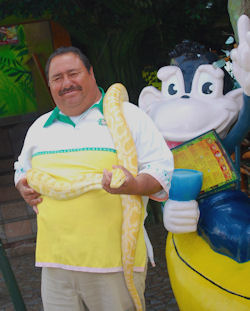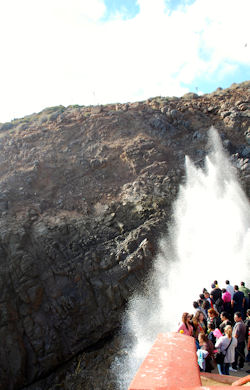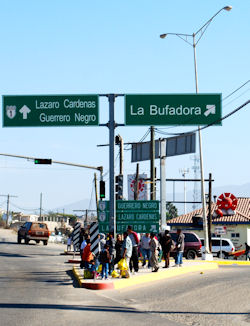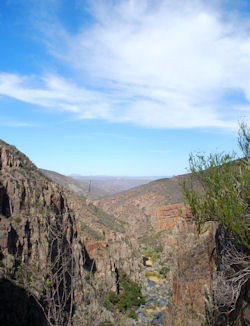 |  |
By Kyle Hargrave

As he begins his tale, beads of perspiration form on his brow. On the horizon, a large pod of gray whales are making their 6,000 mile trip to Arctic waters.
"La Leyenda de La Bufadora," he explains, "is no legend at all." A small crowd begins to assemble around him; some intent on hearing his words, others enticed by the large albino serpent coiled precariously around the storyteller’s neck.
"Not so long ago this bluff was home to a small whaling village," he continues. "The whalers would take advantage of the animal’s annual migration route from the cold waters of the north, to the warm breeding grounds of the south. One night, a mother whale and her new calf stopped here to rest for a night. While the mother whale slept the new calf went exploring and found the cave located right below our feet."
A few brave members of the audience peer over the edge of the bluff, attempting to get a better view. "The calf felt safe entrenched in the sub-marine cave and decided to get some rest. However, while the baby snoozed, he grew, significantly." (Grey whale calves consume up to 50 gallons of their mother’s milk a day and grow between 60-70 pounds daily.) "By the break of dawn, the baby whale found that he was too big to exit the cave he entered the night before. Engulfed in fear, the baby whale called for help by shooting up water from its blow-hole along with its desperate cries." The orator let a pregnant pause ensue. Then, right on cue, a thunderous boom shakes the ground beneath his feet, and a momentous plume of mist spouts from below. "That’s him now; he is bigger now as are his cries for help and his spout."
La Bufadora roughly translates to "water-spout." The natural phenomenon occurs due to a deep underwater canyon which leads into a cave at the bottom of the bluff. As open ocean swells channel through the deep water canyon into the mouth of the cave, air becomes trapped, pressure builds and is released as the water jets skywards followed by a monstrous boom. La Bufadora is largest marine geyser in North America, with water shooting upwards of 100 ft.

Located in the Punta Banda peninsula, about 35-40 minutes outside of Ensenada, La Bufadora makes for a perfect day trip from San Diego. Although the marine geyser is the main act at La Bufadora, it is not the only attraction. The sizzling clams, boisterous venders, bucket sized-piña coladas, and large roaring African jungle cubs is a setting more appropriate for a carnival than the site of a geological monument. In addition to the more traditional Mexican activities, scuba diving is also a popular attraction in the bay. Several multi story restaurants provide perfect viewing platforms where one can view the passing pods of whales while enjoying classic Mexican cuisine or alcoholic refreshments.
Unless you have a scuba dive planned, the amenities and entertainment found at La Bufadora can be exhausted within about an hour. Thus, La Bufadora makes a perfect bookend to Northern Baja day-trip.
There are two main routes from Tijuana to Ensenada. However, on December 28, 2013, the main coastal toll road (Mexico 1) leading to Ensenada collapsed. Those traveling to Ensenada or beyond are rerouted through La Misión and on to the free road. Once on the free road, a ten minute drive will lead to signs pointing to El Salto. Translated to "the jump," El Salto is home to a natural hidden gem. If you are one for rock climbing, hiking, or just enjoying water falls, this is a noteworthy stop. A myriad of trials ranging in difficulty lead to exquisite waterfalls and breathtaking views. Campsites are available as well as secure daytime parking.
A morning hike and then a drive south through the hills near Valle de Guadelupe puts me in state of complete relaxation, save the voracious rumblings from my stomach. The free road leads straight into Ensenada, and just in case you didn’t know, there is almost no better time to be passing through Ensenada than lunch time. The streets are alive as the locals flock to their favorite feeding grounds. The number of quality restaurants per capita in this seafood mecca is unparalleled, however, there is one street cart that demands special recognition. Not just because it has been claimed by more than one food critic as the best food cart in the world, and not just because the owner has refined her culinary prowess for over 30 years. La Guerrerense’s perpetual commitment to deliver fresh and exquisite mariscos dishes is beyond description.
The line at La Guerrerense, composed of a mixed demographic ranging from seasoned locals to sunscreen smelling gringos right off the cruise ship, never seems to dwindle. La Dueña (the owner) is a small unassuming individual whose reputation is rapidly spreading. The freshness of her plates is only rivaled by the sweet bite of her salsas. If ceviche is your forte, then La Guerrerense is your spot. You can find La Guerrerense on the corner of First and Alvarado in front of El Palacio del Perfume.
With the fiery sun serving as the back drop to the migrating whales, I sip on my cerveza and ruminate on a day packed with affordable family fun. I find my bucket list is a few notches shorter: rappel from precipitous cliff over water fall (El Salto), check; savor world class ceviche (La Guerrerense), check; witness one of the largest marine geysers on earth, (La Bufadora), check. Oh yeah, I held a Jaguar cub too, though with disappointment I rub my hand and realize that the bite marks will not scar as desired. With the bill paid, another ground shaking BOOM followed by the distant OOOHHHS and AAAWWWS can be heard as water shoots up and mists down upon the spectators- I think of the baby calf and wonder if it is saying farewell or whether it is still waiting for its lament to be heard.



Photos courtesy of Mrs. Mariana Hargrave.

Easy to use and good peace of mind.

I have been very impressed with the help I received from the insurance. I have used them for years...

I have used Baja Bound for years. Very easy and affordable.